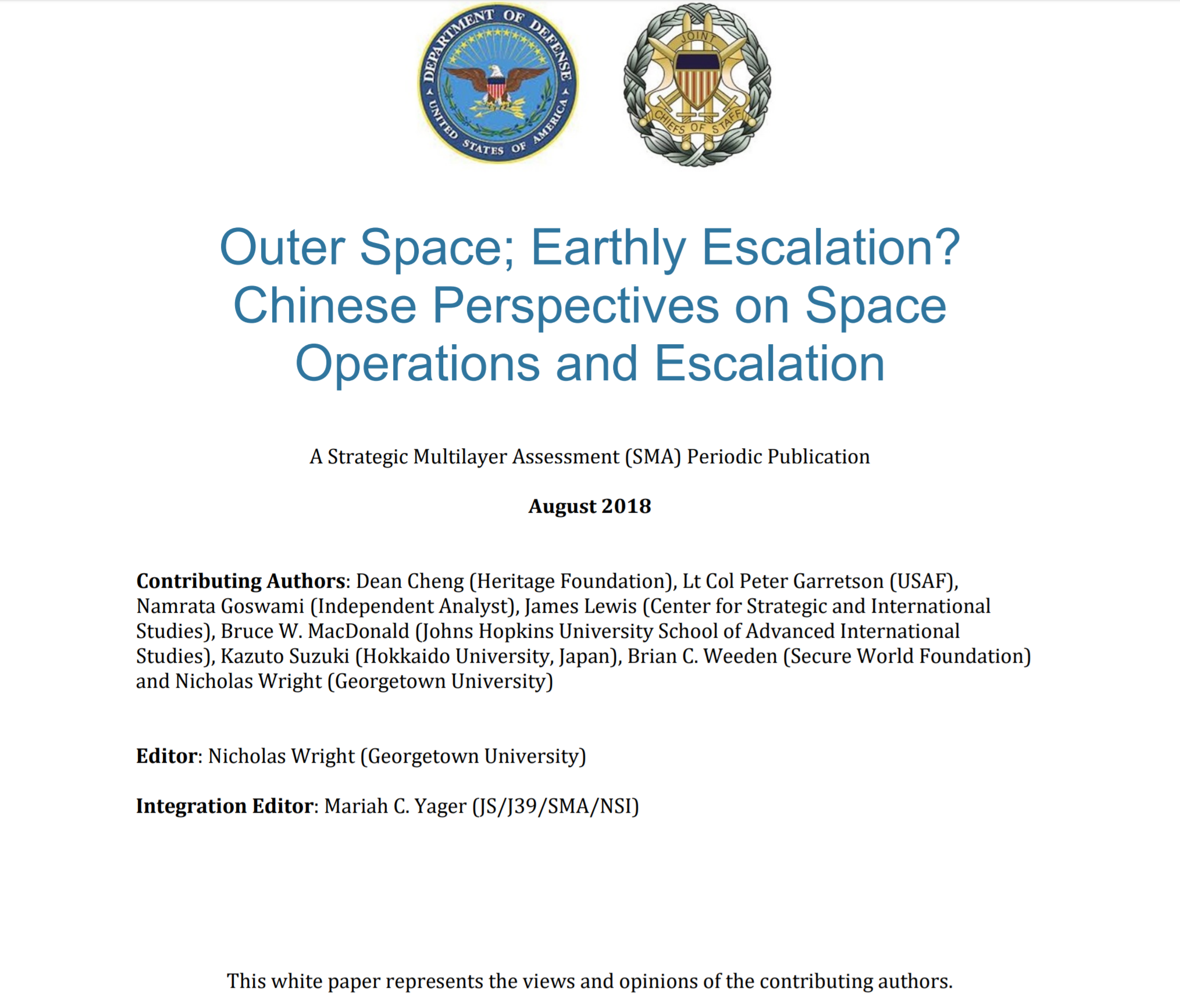Outer Space; Earthly Escalation? Chinese Perspectives on Space Operations and Escalation
Outer Space; Earthly Escalation? Chinese Perspectives on Space Operations and Escalation
Contributing Authors | Editors: Dean Cheng (Heritage Foundation), Lt Col Peter Garretson (USAF), Namrata Goswami (Independent Analyst), James Lewis (Center for Strategic and International Studies), Bruce W. MacDonald (Johns Hopkins University School of Advanced International Studies), Kazuto Suzuki (Hokkaido University, Japan), Brian C. Weeden (Secure World Foundation), Nicholas Wright (Georgetown University), and Mariah C. Yager (JS/J39/SMA/NSI)
Executive Summary
United States policymakers must prepare to manage escalation in West Pacific confrontations that involve space operations. How can they put themselves in the shoes of Chinese planners and manage escalation in the current strategic environment in space? We raise three key points.
(1) Managing space operations now is not the same as in the Cold War Space Age (1957-1990) or the Unipolar US Space Age (1990-2014) – we recently entered a new space epoch, the “Gray Zone-Entangled Space Age.” It has two distinguishing features:
(a) Gray Zone conflict is more than normal competition and less than war. Space strategic conflict mirrors the Gray Zone conflict on earth, with a rising China and resurgent Russia. Space is ideal for Gray Zone conflict, particularly using diverse reversible technologies (Chs. 1 and 8). As James Lewis puts it (Ch. 3): “If America is waiting for the onset of armed conflict, it will miss the game.”
Recommendations: Gray Zone conflict in space is necessarily limited conflict, and thus the central aim is to influence the decision-making of adversaries and other key audiences. Both influence and control are necessary for US success. US space policy and practice must explicitly place influence and control at the heart of space operations.
US decision-makers must have options to respond proportionally to Gray Zone conflict in space, enabling responses without escalation to war. Allies are critical (e.g. Ch. 7 on Japan), as is long-term competition to shape norms (Ch. 8).
(b) Entanglement: Crucial conventional and nuclear space missions are now deeply entangled, so warfighting with near-peers in space for conventional purposes profoundly threatens the nuclear mission. Commercial and military space systems are also increasingly entangled.
Recommendations: In the short-term, US decision-makers must now prepare for space operations during crises to rapidly escalate to the nuclear level (e.g. involving the space-based infrared system; SBIRs). This should be mitigated by dialogue and US deterrent signals. In the medium-term, the US must reduce dependency on fragile, entangled space assets such as SBIRs – and demonstrate that reduced US dependency.
(2) Managing escalation in space operations is not the same as in other domains. The nature of conflict is the same across domains, but the character differs.
Recommendations: Chs. 1, 2 and 7 outline the particular emphases required for space operations, e.g. dealing with ambiguity and offense-dominance.
(3) Chinese strategic thinking on space, escalation, and space escalation differs from US thinking.
Recommendations: To avoid misperception, planners must take seriously different Chinese thinking on space conflict, e.g. related to deterrence or space blockade (Ch. 4). Beyond conflict, the US Government (USG) more broadly must compete for position over longer-term space industrialization (Chs. 5 and 6).

Comments